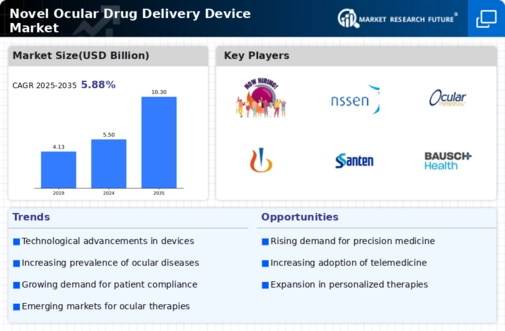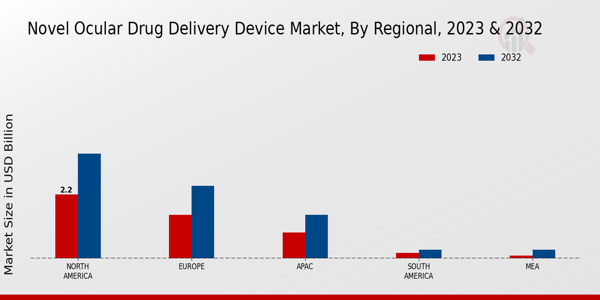Market Growth Projections
The Global Novel Ocular Drug Delivery Device Market Industry is poised for substantial growth, with projections indicating a market value of 5.5 USD Billion in 2024 and an anticipated increase to 10.3 USD Billion by 2035. This growth trajectory suggests a robust compound annual growth rate (CAGR) of 5.87% from 2025 to 2035. Factors contributing to this growth include technological advancements, rising prevalence of ocular diseases, and increasing demand for patient-centric solutions. The convergence of these elements indicates a dynamic market landscape, where innovation and patient needs drive the development of novel ocular drug delivery devices.
Rising Prevalence of Ocular Diseases
The increasing incidence of ocular diseases such as glaucoma, diabetic retinopathy, and age-related macular degeneration is a primary driver for the Global Novel Ocular Drug Delivery Device Market Industry. As the global population ages, the demand for effective treatment options rises. In 2024, the market is projected to reach 5.5 USD Billion, reflecting the urgent need for innovative delivery systems that enhance drug bioavailability and patient compliance. The shift towards targeted therapies necessitates advanced delivery devices, which could potentially improve therapeutic outcomes and reduce systemic side effects, thereby driving market growth.
Regulatory Support and Funding Initiatives
Regulatory bodies and government initiatives play a crucial role in shaping the Global Novel Ocular Drug Delivery Device Market Industry. Supportive regulations and funding for research and development of innovative drug delivery systems encourage investment and innovation. Governments worldwide are increasingly recognizing the importance of ocular health, leading to initiatives aimed at improving access to advanced therapies. This regulatory landscape fosters a conducive environment for market growth, as companies are more likely to invest in developing novel devices. The anticipated market expansion to 10.3 USD Billion by 2035 underscores the positive impact of regulatory support on industry advancement.
Growing Demand for Patient-Centric Solutions
There is a notable shift towards patient-centric solutions in the Global Novel Ocular Drug Delivery Device Market Industry. Patients increasingly prefer devices that are easy to use, non-invasive, and provide a better quality of life. This trend is driving manufacturers to develop user-friendly devices that cater to individual needs. The focus on personalized medicine is expected to propel the market forward, as devices that enhance patient experience and adherence are likely to gain traction. As a result, the market is projected to grow at a CAGR of 5.87% from 2025 to 2035, reflecting the importance of patient engagement in ocular therapies.
Emerging Markets and Global Expansion Opportunities
Emerging markets present substantial growth opportunities for the Global Novel Ocular Drug Delivery Device Market Industry. As healthcare infrastructure improves in regions such as Asia-Pacific and Latin America, the demand for advanced ocular therapies is expected to rise. Increased awareness of ocular diseases and the need for effective treatment options are driving this trend. Companies are likely to focus on expanding their presence in these regions, capitalizing on the growing patient population. This expansion could significantly contribute to the market's projected growth, with estimates suggesting a market value of 5.5 USD Billion in 2024, reflecting the potential of these emerging markets.
Technological Advancements in Drug Delivery Systems
Technological innovations in drug delivery systems are significantly influencing the Global Novel Ocular Drug Delivery Device Market Industry. The development of smart devices, such as implantable drug delivery systems and microneedle patches, offers enhanced precision and control over drug release. These advancements not only improve patient adherence but also optimize therapeutic efficacy. As the market evolves, it is anticipated that these technologies will contribute to an increase in market value, projected to reach 10.3 USD Billion by 2035. The integration of nanotechnology and biocompatible materials further enhances the potential for novel ocular drug delivery solutions.






















Leave a Comment